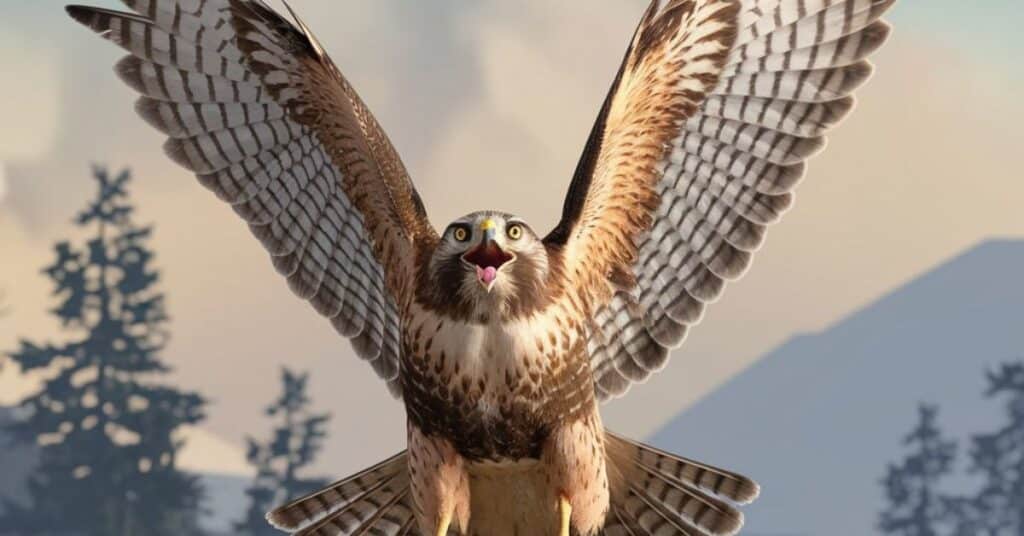Why Do Hawks Screech? those majestic rulers of the skies, have long captivated our imagination with their piercing calls and awe-inspiring presence. But have you ever wondered why these raptors screech? What secrets lie behind their distinctive vocalizations? In this comprehensive exploration, we’ll soar into the world of hawk communication, uncovering the surprising truths behind their iconic screech.
The Anatomy of a Hawk’s Screech
To truly understand why hawks screech, we must first delve into the mechanics of how they produce their unique calls. At the heart of a hawk’s vocal abilities lies the syrinx, a specialized organ found in birds that’s responsible for sound production.
The Syrinx: Nature’s Built-in Synthesizer
Unlike mammals, which have a single voice box (larynx), birds possess a syrinx located at the junction of the trachea and bronchi. This dual-voice box allows hawks to produce a wide range of vocalizations, from high-pitched whistles to their signature screeches.
Here’s a breakdown of how the syrinx works:
- Air flows from the lungs through the bronchi
- Membranes in the syrinx vibrate as air passes
- Muscles control the tension of these membranes
- The shape of the trachea and beak modify the sound
This unique anatomy enables hawks to create their distinctive screech, which can vary in pitch, duration, and intensity depending on the species and the message they’re trying to convey.
The Language of Hawks: Decoding Their Screeches
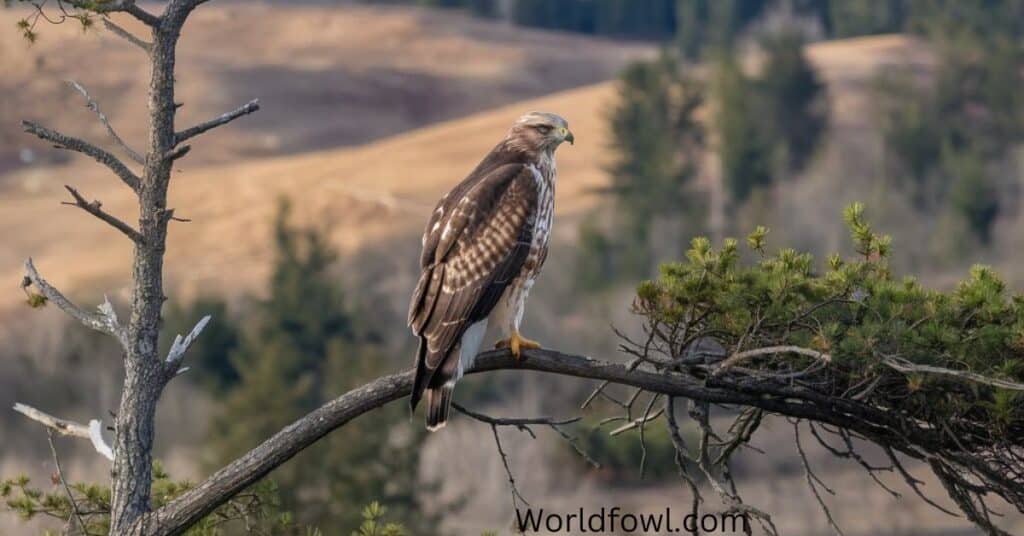
Hawks vocalize for various reasons, each screech carrying a specific meaning. Let’s break down the primary purposes behind hawk screeching:
Territorial Declarations
One of the most common reasons hawks screech is to establish and defend their territory. These vocalizations serve as a warning to other hawks and potential competitors, essentially saying, “This area is taken!”
Case Study: Red-tailed Hawk Territorial Behavior
In a study conducted in Yellowstone National Park, researchers observed that red-tailed hawks increased their screeching frequency by 73% during breeding season, particularly when other hawks entered their territory.
Mating Calls and Courtship
During breeding season, hawk screeches take on a whole new meaning. Males often use distinctive calls to attract females and initiate courtship rituals. These vocalizations can be softer and more melodious than their typical screech.
Warning Signals
Hawks also screech to alert others of potential dangers. This could be in response to:
- Approaching predators
- Human intrusion
- Environmental threats
These warning calls help protect not only the individual hawk but also their offspring and other members of their species in the vicinity.
Parent-Offspring Communication
Hawk parents use various vocalizations to communicate with their young. These can include:
- Food delivery calls
- Danger warnings
- Encouragement for fledglings learning to fly
“The diversity of hawk vocalizations is truly remarkable. Each call serves a specific purpose in their complex social and survival behaviors.” – Dr. Emily Hawkins, Ornithologist
Screeching as a Survival Strategy
Beyond communication, hawk screeching plays a crucial role in their survival tactics. Let’s explore how these raptors use their vocal abilities to thrive in the wild.
Intimidating Predators
While hawks are formidable predators themselves, they’re not without their own threats. When faced with danger, a hawk may unleash a series of loud, aggressive screeches to:
- Startle the potential predator
- Make themselves appear larger and more threatening
- Alert nearby hawks to join in a collective defense
Deterring Competitors
In the competitive world of raptors, resources like prime hunting grounds and nesting sites are highly coveted. Hawks use their screeches to:
- Mark their territory
- Warn off intruding hawks
- Assert dominance in disputes over resources
Alerting the Hawk Community
Hawk screeches can serve as a neighborhood watch system for these birds of prey. A single hawk’s alarm call can quickly spread information about:
- Approaching storms
- Wildfires
- Human activities that might pose a threat
This communal alerting system highlights the social aspects of hawk behavior that many people might not expect from these often-solitary hunters.
The Seasonal Symphony: When and Why Hawks Screech More
The frequency and intensity of hawk screeches often follow seasonal patterns. Understanding these patterns can provide valuable insights into hawk behavior and ecology.
Breeding Season Intensifies Vocalizations
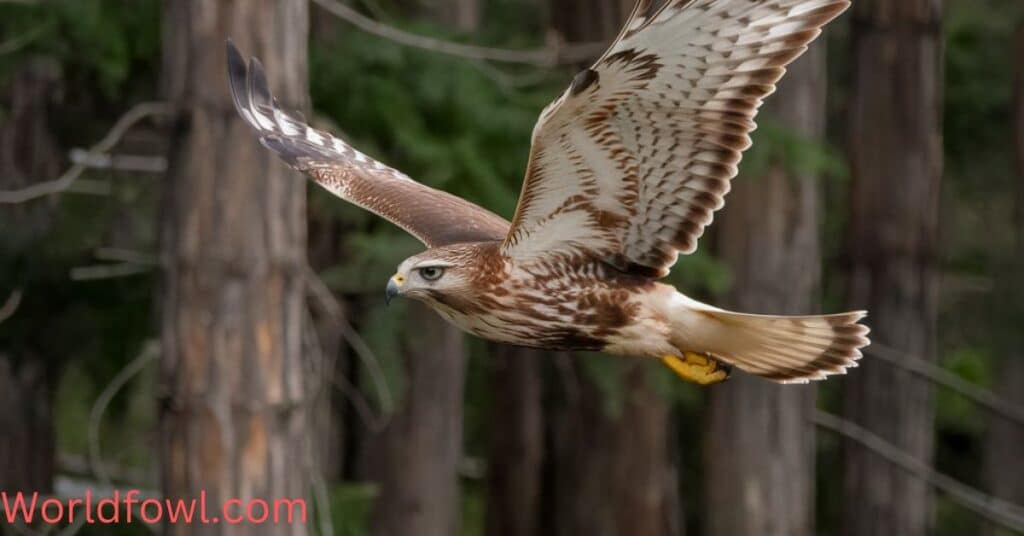
During the breeding season, typically in spring and early summer, hawk screeching reaches its peak. This increase in vocalization is due to:
- Territorial defense becoming more critical
- Courtship rituals requiring frequent communication
- The need to coordinate nesting activities with mates
Breeding Season Vocalization Intensity
| Species | Normal Vocalization | Breeding Season Increase |
| Red-tailed Hawk | Moderate | 150-200% |
| Cooper’s Hawk | Low | 300-400% |
| Sharp-shinned Hawk | Very Low | 500-600% |
Migration Periods and Increased Communication
As hawks prepare for and undertake their seasonal migrations, their vocalizations often increase. This is due to:
- Gathering in larger groups before migration
- Coordinating movements during flight
- Establishing temporary territories at stopover sites
Winter Screeching Patterns
While generally quieter in winter, hawks still vocalize for various reasons:
- Defending winter territories
- Communicating with potential mates for the upcoming breeding season
- Warning others about scarce food sources
Hawk Species and Their Unique Calls
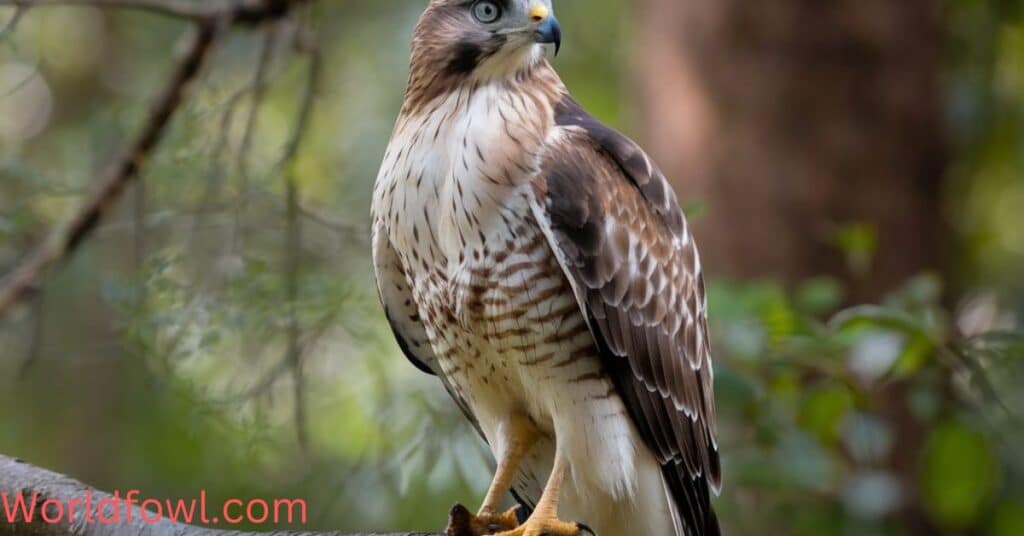
Not all hawk screeches are created equal. Each species has its own distinctive vocalizations, shaped by evolution to suit their specific needs and habitats.
Red-tailed Hawk’s Iconic Scream
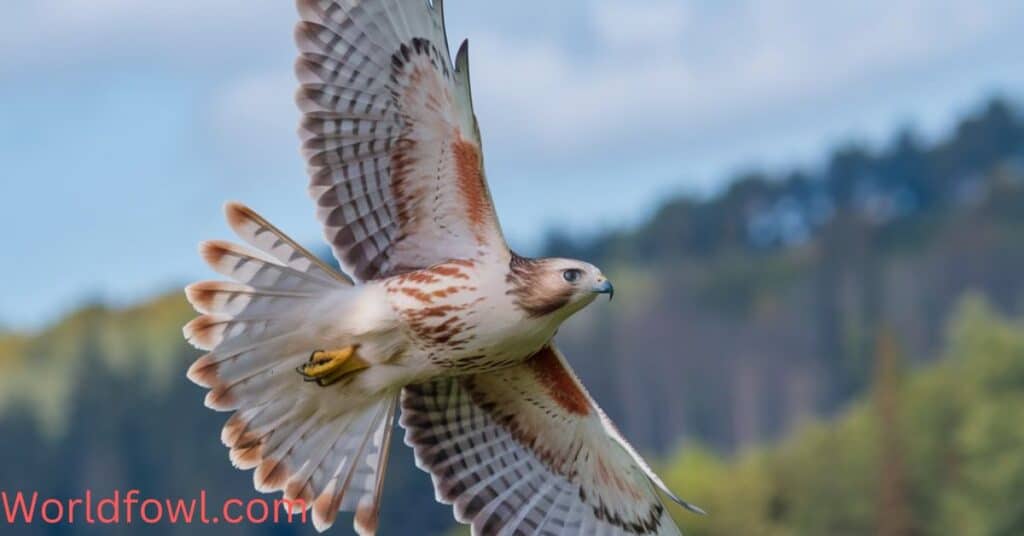
The red-tailed hawk’s screech is perhaps the most recognizable of all hawk sounds. Often used in movies to represent eagles (which actually have a much less impressive call), the red-tailed hawk’s vocalization is:
- A loud, raspy “kree-eee-ar”
- Lasting about 2-3 seconds
- Often repeated several times
Cooper’s Hawk’s High-Pitched Chatter
In contrast to the red-tailed hawk, the Cooper’s hawk has a much different vocal repertoire:
- A rapid series of “kek-kek-kek” calls
- Higher in pitch than many other hawks
- Often described as sounding like a large songbird
Sharp-shinned Hawk’s Shrill Kik-kik
The smallest of North America’s hawks, the sharp-shinned hawk has a vocalization that matches its size:
- A high, thin “kik-kik-kik”
- Often given in flight or when agitated
- Can be mistaken for a large woodpecker at times
“Each hawk species has evolved its unique vocal signature, perfectly adapted to its ecological niche and communication needs.” – Dr. Richard Raptor, Hawk Behavior Specialist
The Urban Hawk: Adapting Screeches to City Life
As human populations expand, many hawk species have adapted to urban environments. This shift has led to fascinating changes in their vocalizations and communication strategies.
How Urban Environments Affect Hawk Vocalizations
Urban hawks face unique challenges that influence their screeching behavior:
- Increased background noise: Hawks may screech louder or at different frequencies to be heard over city sounds.
- Changed acoustics: Buildings and other structures alter how sound travels, affecting how hawks communicate.
- New predators and competitors: Urban hawks may develop new vocalizations to deal with novel threats like domestic cats or competing bird species.
Interactions with Human-Made Sounds
Some intriguing adaptations have been observed in urban hawks:
- Timing shifts: Some hawks have been found to vocalize more during quieter periods, like early morning or late evening.
- Mimicry: In rare cases, urban hawks have been observed incorporating human-made sounds into their calls, such as car alarms or sirens.
Urban Hawk Populations and Their Communication Challenges
Urban living presents unique communication challenges for hawks:
- Territory fragmentation: With less continuous habitat, hawks must adapt their territorial calls to cover disjointed areas.
- Light pollution: This can affect nocturnal vocalizations, potentially extending the hours during which hawks communicate.
- Human interactions: Urban hawks may develop specific calls to warn off humans who come too close to nests.
Nighttime Serenades: Hawks That Break the Silence
While most hawks are diurnal (active during the day), some species break this mold, leading to nighttime screeching that can startle unsuspecting listeners.
Nocturnal Hawk Species and Their Calls
Several hawk species are known to be active and vocal at night:
- Ferruginous Hawk: Occasionally hunts at night, especially during full moons.
- Harris’s Hawk: Known to hunt in low light conditions and may vocalize at dawn and dusk.
- Red-shouldered Hawk: Sometimes calls at night, especially during breeding season.
Reasons for Nighttime Screeching
Hawks may screech at night for various reasons:
- Territorial defense: Nocturnal intruders may prompt defensive screeching.
- Mating rituals: Some species engage in courtship behaviors at night.
- Hunting: Night-active hawks may vocalize while pursuing prey.
- Disturbance: Human activities or unusual events might cause hawks to screech at night.
Comparison with Other Nocturnal Birds
It’s important to distinguish hawk screeches from those of other nocturnal birds:
| Bird Type | Call Description | Active Hours |
| Hawks | Varied, from screech to whistle | Mostly day, some night |
| Owls | Hoots, screeches, barks | Primarily night |
| Nightjars | Whip-poor-will, chuck-will’s-widow | Dusk to dawn |
| Herons | Harsh squawks, croaks | Day and night |
The Impact of Climate Change on Hawk Vocalizations
As our planet’s climate shifts, so too do the behaviors and adaptations of wildlife, including hawks. These changes are having surprising effects on hawk vocalizations.
Shifting Territories and New Vocal Adaptations
Climate change is altering the range of many hawk species, leading to:
- New neighbors: As ranges overlap, hawks may develop new vocalizations to compete with unfamiliar species.
- Changed acoustics: Different environments may require hawks to adjust their calls for optimal sound transmission.
- Seasonal shifts: Changes in breeding seasons may alter the timing and frequency of mating calls.
Changes in Prey Availability Affecting Communication Patterns
As climate change impacts prey populations, hawks are adapting their hunting and communication strategies:
- New hunting calls: Hawks may develop vocalizations to coordinate group hunting of new prey species.
- Altered territory defense: Changes in resource availability may intensify territorial screeching.
- Increased stress calls: More frequent extreme weather events may lead to more distress vocalizations.
Research on How Global Warming Might Alter Hawk Calls
Scientists are actively studying how climate change affects hawk vocalizations:
- Frequency analysis: Researchers are comparing recordings of hawk calls over decades to detect subtle changes.
- Behavioral studies: Observations of hawk communication in areas experiencing rapid climate change provide valuable insights.
- Predictive modeling: Scientists are using climate models to predict future changes in hawk vocalizations and behavior.
“The way hawks screech today may be very different from how they’ll communicate in 50 years. Climate change is rewriting the avian language.” – Dr. Clara Climate, Ecological Acoustics Researcher
Listening to Hawks: A Birdwatcher’s Guide
For those eager to experience the thrill of hearing a hawk’s screech in person, here are some tips to enhance your birdwatching experience.
Tips for Identifying Hawk Species by Their Calls
- Learn the basics: Familiarize yourself with common hawk calls through online resources or birding apps.
- Consider context: Note the time of year, location, and behavior of the hawk when you hear it.
- Use technology: Recording apps can help you capture and later identify unfamiliar calls.
- Practice, practice, practice: The more you listen, the better you’ll become at distinguishing different hawk species.
Best Times and Places to Hear Hawk Screeches
To maximize your chances of hearing hawk vocalizations:
- Time of day: Early morning and late afternoon are often most active
- Seasons: Spring and early summer during breeding season
- Locations:
- Open fields with scattered trees
- Forest edges
- Cliff faces in mountainous areas
- Urban parks with mature trees
Ethical Considerations When Observing Hawks
Remember to practice responsible birdwatching:
- Maintain a safe distance to avoid disturbing nesting sites
- Never use recorded hawk calls to attract birds, as this can disrupt their natural behavior
- Respect private property and protected areas
- Share your observations with local birding groups or scientific databases to contribute to hawk conservation efforts
The Cultural Significance of Hawk Screeches
Hawk vocalizations have left an indelible mark on human culture, from ancient myths to modern media.
Native American Legends and Symbolism
- Messenger: Hawks are often seen as messengers from the spirit world
- Wisdom: The hawk’s screech is sometimes interpreted as a call to pay attention to one’s surroundings
Hawks in Literature and Art
Hawks and their distinctive calls have inspired countless works:
- Poetry: Poets like Robinson Jeffers have used hawk imagery to symbolize wildness and freedom
- Paintings: Artists such as John James Audubon famously depicted hawks in their natural habitats
- Novels: Books like Helen Macdonald’s “H is for Hawk” explore the deep connection between humans and these birds
Modern Pop Culture References to Hawk Calls
The distinctive screech of a hawk has become a staple in various media:
- Movies: Often used to establish a wilderness setting or to build tension
- Video games: Hawk calls frequently feature in open-world games to create immersive environments
- Advertising: The powerful image of a screeching hawk is sometimes used in commercials to convey strength or freedom
Conclusion:
As we’ve explored, the reasons behind hawk screeching are as varied and complex as the birds themselves. From territorial declarations to mating calls, from warning signals to parent-offspring communication, these vocalizations play a crucial role in hawk survival and social behavior.
Yet, for all we’ve learned, much remains unknown about hawk communication. Ongoing research continues to uncover new insights into how these magnificent birds use their voices to navigate their world.
As our planet changes and hawks adapt, their screeches may evolve in ways we can’t yet predict. By listening closely and observing carefully, we not only gain a deeper appreciation for these remarkable raptors but also glean valuable information about the health of our ecosystems.
So the next time you hear a hawk’s piercing cry echo across the sky, remember: you’re not just hearing a bird call. You’re listening to a complex language shaped by millions of years of evolution, a testament to the intricate web of life that surrounds us all.
FAQs
To wrap up our exploration, let’s address some common questions about hawk vocalizations:
Do all hawks screech? A: While most hawks can produce screeching sounds, not all species vocalize frequently. Some, like the red-tailed hawk, are known for their loud calls, while others, like the sharp-shinned hawk, tend to be quieter.
Can hawks mimic other bird calls? A: Unlike some birds, such as mockingbirds or parrots, hawks generally do not mimic other species. Each hawk species has its own distinctive set of vocalizations.
How far can a hawk’s screech travel? A: The distance a hawk’s screech can travel depends on factors like the species, the environment, and weather conditions. In ideal conditions, some hawk calls can be heard up to a mile away.
Do hawks screech while flying? A: Yes, hawks often vocalize while in flight. This can be for various reasons, including territorial warnings, communication with mates, or signaling to offspring.
Can hawk screeches harm human hearing? A: While hawk screeches can be startling and loud, they are generally not harmful to human hearing at normal distances. However, very close exposure to any loud sound, including bird calls, could potentially cause discomfort or temporary hearing issues.
By understanding the complexities behind hawk screeching, we gain a deeper appreciation for these magnificent birds and their role in our world. Whether you’re a seasoned ornithologist or a casual nature enthusiast, the call of a hawk remains one of nature’s most thrilling sounds, a reminder of the wild and wonderful world that surrounds us.

Henry James is a seasoned blogger and a passionate storyteller on “World Fowl.” With years of experience crafting engaging content, he brings a unique blend of expertise and creativity to his writing. Henry specializes in exploring diverse topics with depth and clarity, captivating readers worldwide.

